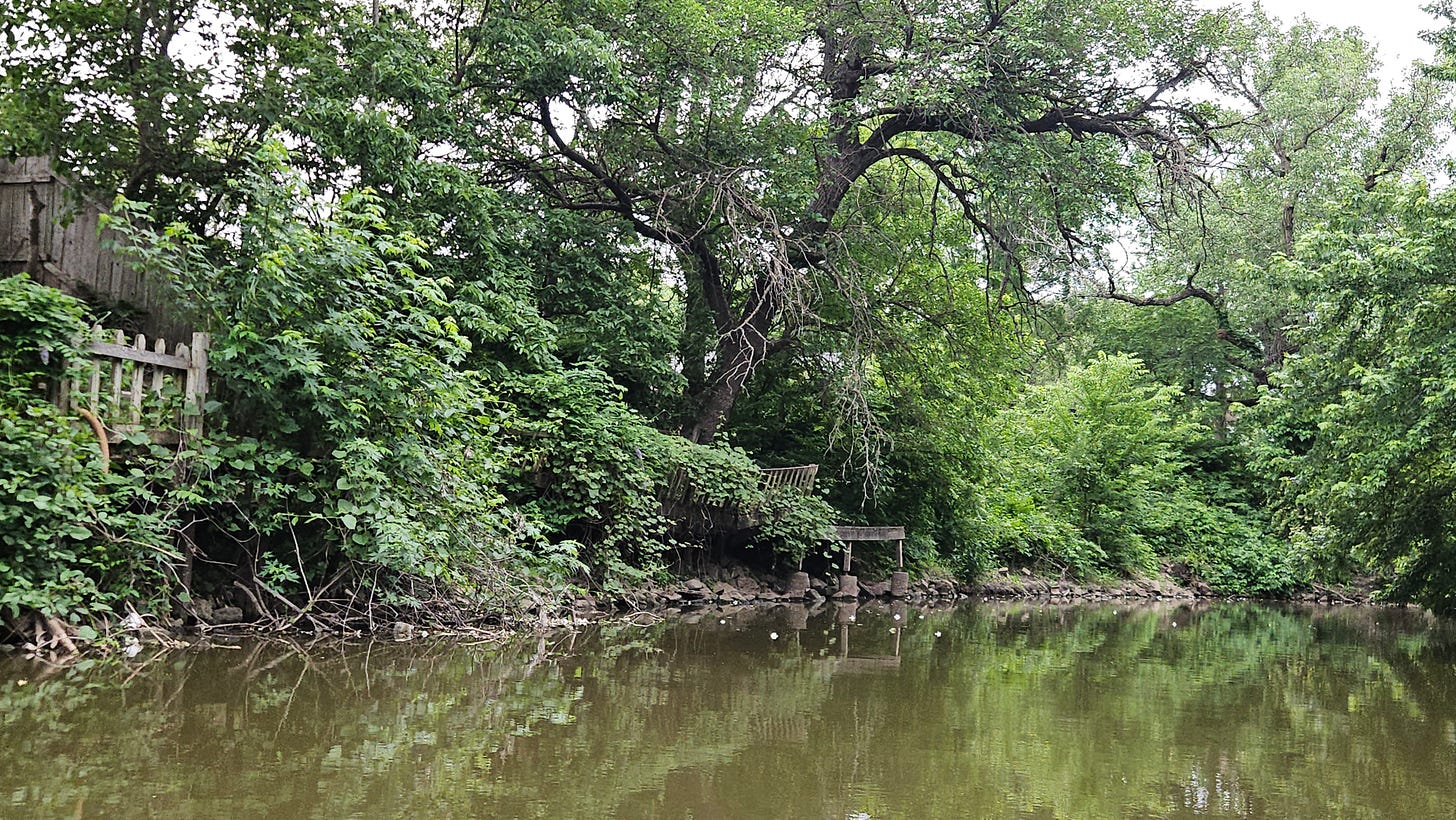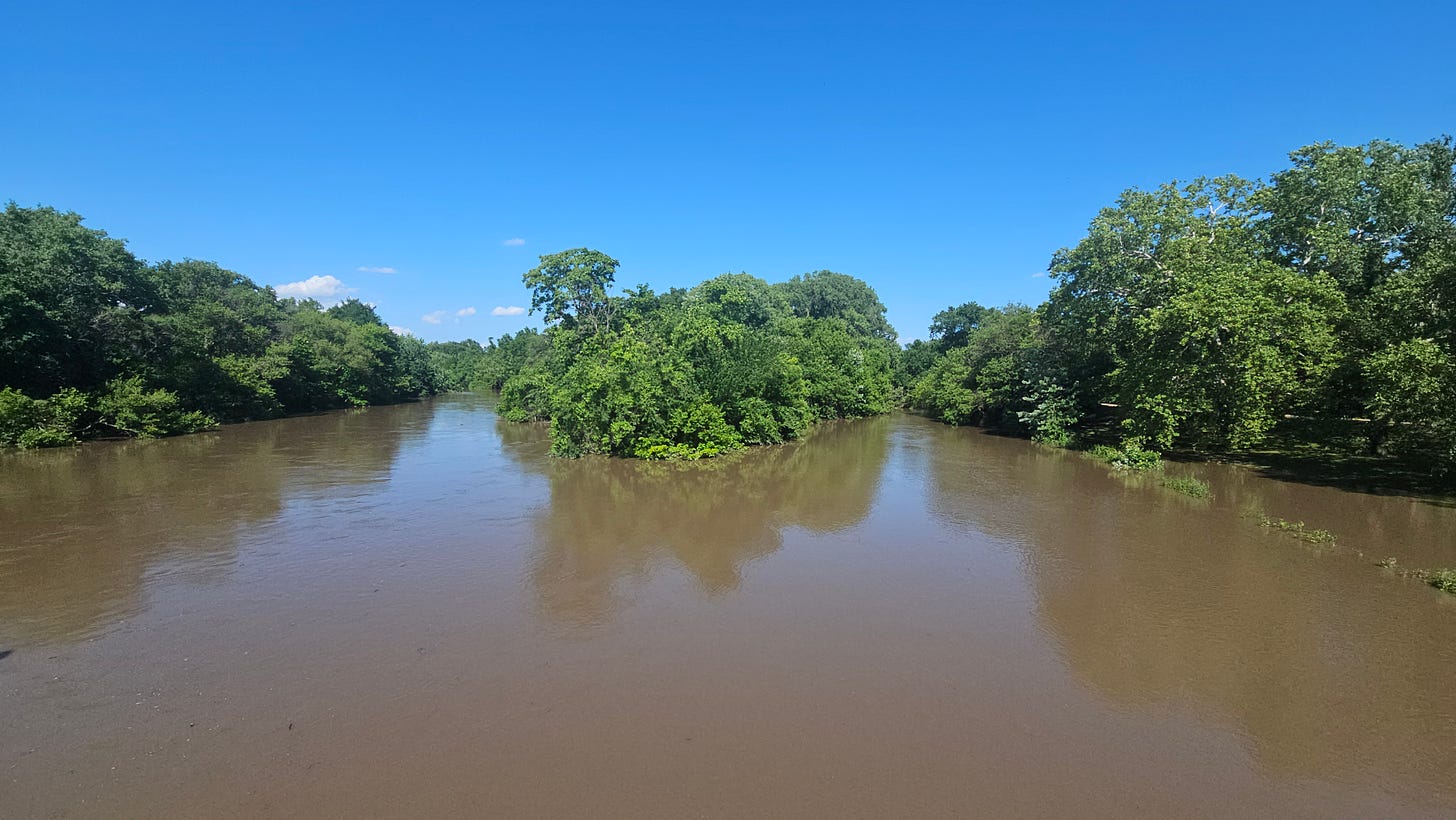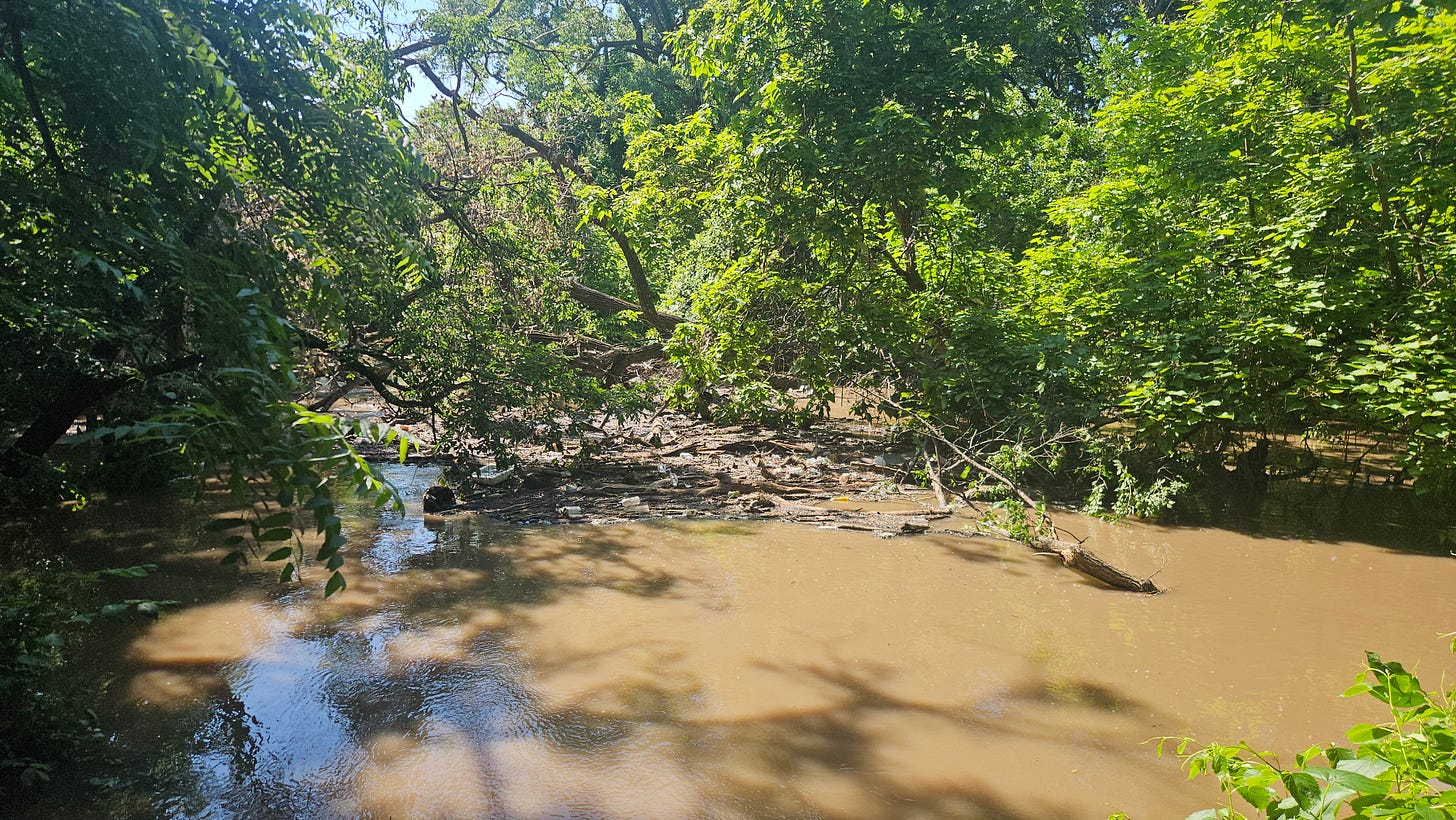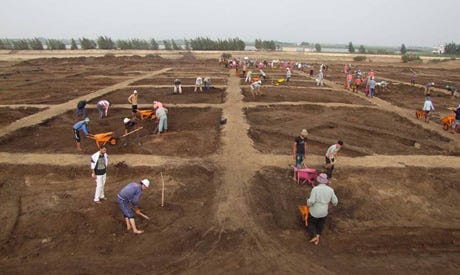
Two weeks ago, in Return to Paradise, I began a brief outline of the problems facing the Little Arkansas River between the Minisa and Nims bridges. It would be convenient if the problems facing this area were an isolated phenomenon. But the challenges the Green Tunnel faces are just a microcosm of a systemic issue with urban waterways in Kansas.
Last week, I planned to go deep on threats the river faces. Unfortunately, clues for the annual Wichita Medallion Hunt created a lot of talk about people trying to get on Mead Island to look for said medallion. This article was pushed back for the sake of an emergency installment, warning people the river conditions were treacherous, the island is inhospitable, and the medallion would not be there based on the rules and clues. As I went to publish the article, the medallion was found. While the island was safe from flocks of medallion hunters disturbing the ecosystem and inevitably leaving trash behind, the underlying threats to the river and the island remain.
Siltation, pollution, and (from a resident’s perspective) a never-ending influx of trash and debris threaten the long term health of the river ecosystem and the Wichita Riverside community. The large logs that come down the river back up most under bridges—an obvious threat to our infrastructure—but occasionally lodge in the river bed, especially in low water. The trash piles up behind these log jams creating the kind of sad pictures that were in my first piece in what is now becoming a multipart series. But underneath the surface, the biggest threat to the river and the humans living close-by swirls and comes to rest on the river bed.
Silt, loaded with powerful pollutants, forms a sludgy, viscous layer between the sand and water. Strong currents have trouble dispersing this silt, meaning normal conditions don’t disturb it much at all without debris or activity physically agitating the bottom. This situation means that toxins and other pollutants stay embedded in the river until massive rainwater events. It starts with logs and trash that volunteers like SNEK can easily clean up. But it ends with a much bigger problem that the Environmental Protection Agency’s EJ Screen tool warned about until it was removed from their site in February of 2025.
In 1927, a 75-year-old Wichita elder, Suck-ah, said a prayer on Mead Island during the construction of the traditional grass lodge the tribe built there. The prayer was offered for the lodge and the people of Wichita. No verbatim transcript of her prayer exists, but I like to think she prayed for the health of the river and ecosystem around it as well. It’s something I think about every time I visit the island: A woman that lived through the civil war, was likely forced to leave this place she called home, yet still had so much love to give to our city, our river, and Mead Island. Did we let her down? Let’s take a deep dive into the threats facing all three.
Debris: A Persistent Menace
Log jams and trash are constant threats. Our recent cleanup moved tons of debris, but without city intervention, it just piles up again. The fallen cottonwood in the tunnel is a great example of why. Removing the 150 year-old fallen tree and the mass of logs behind it could cost anywhere from $5,000–$30,000 once the cost of equipment, labor, and bank stabilization is included.
Being proactive isn’t necessarily cheaper. Temporary debris booms ($2,000–$5,000 each) could catch floating logs before they lodge under bridges or on Mead Island’s banks. Once captured, the city would still need access to do regular cleanups like the ones that occur near the Ralph Wulz Riverside Tennis Center. Community cleanups, like the annual Downtown Wichita Cleanup, could help alleviate the problem, but the institutional momentum and donor money consistently flows downstream from the mouth of the Little Ark to the areas of the Arkansas River proper that host the new apartments on the riverwalk and the annual Riverfest gathering.
A more proactive approach has already been doing wonders for 7 years in a city once known for having the most polluted river in Europe, Amsterdam. The Great Bubble Barrier was built in 2019 at the outlet of the city’s historic canals into the River IJ. It has been so successful, four more have already been installed at Harlingen, Vila do Conde, Katwijk, and Wervershoof. The solution is innovative but simple: a bubble curtain is created across the bottom of a river by pumping air through a perforated tube secured across the riverbed diagonally. The bubbles lift and push semi-buoyant debris into special catchment systems for disposal. It is widely lauded as one of the most effective and energy-efficient solutions to trap plastics. The best part? Bubble barries don’t hinder aquatic life or boating. Similar projects in the US have been used to prevent hazardous algal blooms and keep jellyfish off of beaches.
While large projects like the one the IJ can cost upwards of $350,000, a similar project across the Little Arkansas north of the Minisa Bridge would ostensibly cost far less on such a narrow river and could utilize municipal infrastructure already nearby (North High or Minisa Park, for example). The system could also trap large logs closer to shore before they get lodged under bridge pylons, greatly decreasing the taxpayer burden of removing them from less advantageous locations.
Siltation: The Muck that Binds Us
Silt—fine sand, clay, or other material carried by running water and deposited as a sediment—is nothing new. Over the course of human history, it’s been a critical resource contributing to the rise of great civilizations that gave our species agriculture and food security; think of the Tigris and Euphrates in Mesopotamia, the Nile in Egypt, the Indus Valley in India, or the Yellow River in China. Siltation is just the process of this critical substance filling in bodies of water.
Without silt, we would all be hungrier. But thousands of years later, managing silt seems to have become a lost art. Sure, Big Ditch Mitch stopped the floods, but channelization and damming rivers has an unintended consequence of letting the silt pile up. And since the 1950s, when these massive improvements were made to Wichita, the problem of silt has reached a tipping point. It’s no different than the Pelusiac Branch of the Nile being lost to siltation in 25 AD, which not only cut off an important transportation route from the Sinai to the heart of the Nile Delta, but also encouraged the population there to move from agriculture to full scale industrial iron and bronze production.
Low water levels, both a symptom and a cause of heavy siltation, make the Green Tunnel and Little Arkansas River nearly unnavigable for much of the year. Sediment buildup reduces depth to mere inches in places, trapping logs and trash and creating stagnant pools. This siltation exacerbates hazards for boaters, as I’ve experienced trying to row a 14’ jon boat through debris-choked waters. Even with a minimal draft, it takes a keen eye to note where ripples on the surface warn of a sludgy trap below. Dredging to restore a six-foot depth could cost anywhere from $500,000 to $2M. And while it’s not even close to the sum Wichita has written off in taxes for special development projects, that’s a lot of money for a city with massive budgetary issues.
But there is something even darker hiding beneath the muck. In 2001, a Stakeholder Leadership Team of volunteer landowners, producers, residents, and Kansas Department of Health and Environment representatives were sounding the alarm. They began work compiling data and making a plan to deal with siltation of the watershed and the pollution lodged therein. In their Little Arkansas Watershed Restoration and Protection Strategy Final Plan (September 2011), they noted the main pollutants of concern were atrazine, sediment, nutrients, and fecal coliform bacteria (yes, you read that right, they are talking about poo). Stone, writing for the USGS in 2023, notes that sediment loads in the Little Arkansas River are highly sensitive to climatic variation, with extreme precipitation events increasing pollutant loading. In short, the problem of silt has only gotten worse over 25 years, both quantitatively and qualitatively.
Atrazine: Silent Spring 2.0
Yea, it’s that chemical that a madman once said made frogs gay. This couldn’t be further from the truth—it was actually causing the frogs to transition, if anything. And while it always generates a laugh, the way certain political factions have embraced this issue distracts from the reality. Atrazine, a commonly (over-) used herbicide, is an endocrine disruptor shown to affect sexual differentiation of the brain in animals when exposed during fetal development.
Atrazine levels peak during runoff events (ie: when it rains a lot) and during periods of application (typically overlapping between March and June). This is also coincides with some of the highest levels of turbidity and silt being deposited in the river. The high acreage of row crops along the Little Ark tributaries of Turkey, Kisiwa, Emma, and Sand Creek contribute to these tributaries consistently measuring above EPA criterion for aquatic impairment during runoff events—and it all flows into Riverside. In short, Wichita is storing vast quantities of a known endocrine disruptor in feet of silt lingering under the surface of the Little Arkansas river.
Atrazine may be feminizing our frogs—but that’s not the critical issue. Without any reference to the culture war delirium of the last 10 years, it’s certainly disrupting the endocrine systems of animals and people around it. According to the National Institute of Health, studies have shown atrazine exposure to be correlated to reduced sperm count, impaired male reproductive development, increased infertility, higher risk of preterm birth, low birth weight, birth defects in newborns, impaired fetal growth, increased risk of various cancers, impaired immune function, delayed neurological development, and damage to the liver, kidneys, and heart.
I and another volunteer leader of SNEK have both experienced immersion in the Little Arkansas while using boats to clean up the Green Tunnel. In both cases, within 15 minutes of exiting the water, we experienced flushing of the skin and a burning sensation until a shower or hose washed away the toxins. Per the Material Safety Data Sheet for Atrazine 4L, a common formulation, this is directly attributable to Atrazine. This is why SNEK has consistently warned participants of health risks during cleanups, limited participation in operations on the water, supplied PPE to anyone working near the water, and always had a garden hose at the ready during cleanups. It’s that bad.
Atrazine is banned in 63 countries due to persistent loads found in groundwater. It’s high time the United states catch up to the EU, Cameroon, Chad, and Syria. Hell, Atrazine has been banned in Switzerland since 2012, even though Syngenta, Atrazine’s primary manufacturer, is based there. Ironically, in the same year, the company settled a class action lawsuit with community water systems across the Midwest for $105M. The company admitted no wrongdoing—just a slap on the wrist. Robert F. Kennedy Jr. and the MAHA movement could easily score a popular win on this kind of 80-20 issue if the Secretary of Health wasn’t too busy swimming in poo water. Speaking of… maybe RFK Jr. should come swim in the Little Ark!
Wastewater: Turning Rivers into Open Sewers
My own work with SNEK and Sunflower Community Action as an environmental justice organizer exposed me to the EJ Screen tool as a way to visualize and tell the story of how this pollution impacted ecosystems and communities. The EJ Screen tool was a novel way to view environmental issues: no longer was demographic and health data segregated from the quantifiable impacts of pollution and climate change. The tool allowed organizers to view environmental issues from the lens of disadvantaged communities, supplying environmental justice index scores to show the disproportionate burden born by citizens living in poverty, communities of color, disabled persons, and more. As impressive as linking census, health, and environmental data in one database was, the numbers were disheartening.
Take for instance the four census tracts that make up riverside and the area between Delano and the Central Business District. In 2023, when separated from the EJ Index and exclusively measuring toxicity-weighted concentrations, the areas adjacent to the Little Arkansas in Wichita ranked in the 87th percentile nationally (0.17 TWC/m, if you were wondering). That means only 13% of the United States can claim to have more wastewater discharge than these four census tracts. That’s a lot of wastewater—much of it coming from outdated and unregulated stormwater drains being used as wastewater output from the basements of old houses in historic neighborhoods. That’s bad enough on face.
But the approximately 14,000 inhabitants of the 3.79 square miles were (and ostensibly still are) in the 94th percentile for wastewater discharge statewide and the 88th percentile nationally when measured using the Environmental Justice Index. That indicates the economic and demographic realities of who bears this burden: people of color, the poor, the disabled, people that only speak Spanish. Six percent of Kansas census tracts can say their historically disadvantaged communities experience this kind of pollution. These are communities with less options, longer working hours, less money, and less historic access to state and municipal government. While the Riverwalk development gets special care and backroom deals, Riversiders are left to just deal with it. But how did it get this bad?
The easiest way to explain it is, homeowners updated basements with bathrooms, laundry machines, and sinks; the black pipe was overhead, but the sump pump was right there. While the black pipe lead to a sewer, the sump often leads directly to the river. The easiest way to stop it? Regressive sampling at multiple locations within Wichita to determine the location of sites where wastewater is entering the river.
The part that is not as much fun for property owners is the real solution, though: cease and desist orders, fines, fees, and city inspection of stormwater systems leading to the river ensuring compliance. Draconian? Maybe, but hey—it would keep fecal coliform bacteria from festering in the muck, potentially offset costs of other projects on the river, and maybe even spur a niche engineering and plumbing industry that could create jobs. Besides, if Wichita city government wants to claim they govern for all, is it really that unorthodox to have policies around wastewater the same teeth as the ordinances governing mowing your yard?
Dredging: A Cost Prohibitive Imperative
Even if the City of Wichita were to build bubble barriers, curb wastewater inputs, and the state or federal government somehow gets farmers to stop spraying fields with atrazine like baby oil at a Diddy party, the silt at the bottom of the Little Arkansas is still loaded with contaminants. Natural ecological processes won’t fix that. If you ever have the unpleasant occasion to pull some silt off the bottom of the Little Ark, you will notice it is black and reeks like sewage. Side note: don’t actually go do this, it’s bad for you. That’s not goose poo in that muck—it’s human. Worse, while atrazine has no smell, it prevents aquatic flora from taking root in the banks and preventing erosion. This all leads to more silt, more health consequences, and more ecological damage.
There really is one solution for saving the Little Arkansas, the Green Tunnel, and Mead Island. Even if it does cost two-million dollars or more, that sludge can’t be left there. It needs to be pumped out of the riverbed and properly disposed of. If the city says it will cost too much, there is still a path forward, albeit one that the mere mention of may cause panic among city managers and corporate boards: the Comprehensive Environmental Response, Compensation, and Liability Act (CERCLA), AKA: The Superfund Act. For over 40 years, this piece of legislation has maintained a trust fund (ie: “The Superfund”) and granted the EPA the power to identify and hold responsible liable parties for cleanup costs. Responsible parties are required to cleanup their pollution or reimburse the federal government for cleanup costs.
It’s a cornerstone of environmental protection and the equivalent of a legal billy club to be brandished at polluters or the governments that enable them. The city of Philadelphia was forced to remit $8.4M for cleanup of the Lower Darby Creek Superfund Site. Cahokia Heights, IL, paid a $30,000 civil penalty and was forced to implement $30M in compliance measures. This certainly isn’t lost on the City of Wichita, currently on the hook for an undisclosed sum to the EPA as part of the 29th & Mead (Groundwater Plume) Superfund Site after a 1994 consent decree. Total remediation costs for the site were estimated between $20M-$30M. Sources would suggest a $1M-$6M burden on the city, but (unsurprisingly) no concrete data is publicly available to pin these numbers down. It goes without saying, this probably isn’t the path Wichita wants to keep treading.
Suck-ah’s Prayer, Our Answer
It’s easy to get lost in the natural beauty of the river. But then comes the more utilitarian thoughts… If the Green Tunnel was part of a flood mitigation strategy, what happens when it completely silts in? What happens if these recent floods continue and that toxin-laced silt ends up in a park or a home and ruins them? If the city can’t pay to remediate the issue, what kind of inflated costs will the EPA charge taxpayers over the next thirty years? And If the river does get designated a superfund site, what does that mean for the shiny new apartments down stream? While the water is high now, what about if drought conditions return, exposing large patches of freshly deposited toxic silt, and convert it to dust in the air?
Simply put, even if you care infinitely more about money than the environment, the impacts could be incalculable. The loss of tax revenue from any of these hypothetical situations should upset anyone that cares about Wichita. If the flood plan fails, property values will drop, leaving anyone with a mortgage underwater both literally and figuratively. If infrastructure and improvements are destroyed by a flood event, they will need special cleanup as well. Does anyone truly believe the Riverwalk development project will generate revenue if residents find out they are paying top dollar for apartments and condos that overlook a toxic river?
It’s hard not to think back to Suck-ah and wonder what she would think about all this. What would she say to us today? Mead Island (along with Oak Park) are some of the last old growth stands in the Riverside area. The roots of the cottonwoods, catalpas, and oaks are our roots. The shade they cast once extended across the whole of the area between the big and Little Arkansas rivers. Are we too far gone to recognize what’s at stake if these conditions continue? Or can we get city government to buckle down and pay for the pound of cure and multiple ounces of prevention? All the Portland Loos and proclamations in the world can’t compete with the impacts of serious care for the Little Arkansas.
There are some city leaders that may even be amicable to pushing real reforms through the bureaucratic pipeline. It’s important to remember who is working for all of us. But there are also holdouts. Tune in next week to see exactly what steps locals could take to turn up the pressure on city leaders to return the Little Arkansas to her former glory and answer Suck-ah’s prayers. While you wait, get out there and float around the island—the city has kayaks for rent at the Riverside Tennis Center if you can tough out the upstream paddling. When you get there, listen closely; you might just hear Suck-ah’s words still reverberating across the water.








